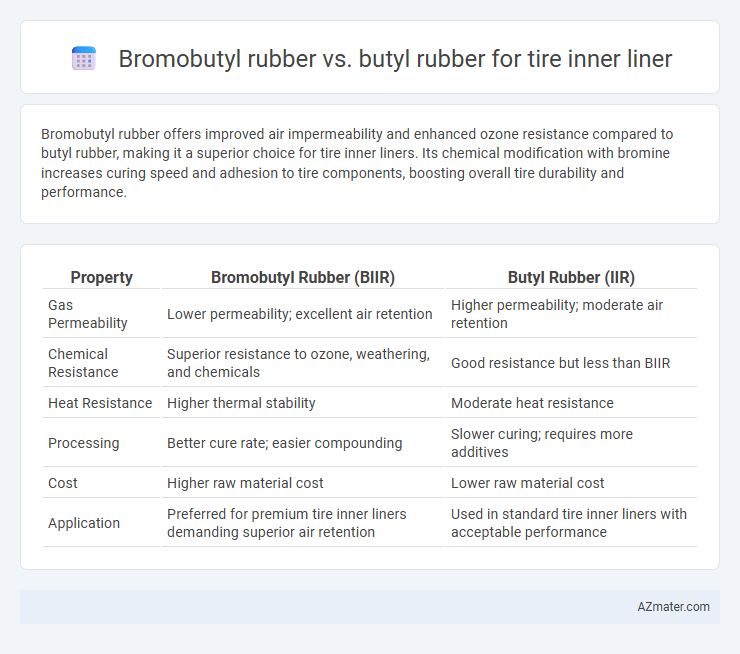Bromobutyl rubber offers improved air impermeability and enhanced ozone resistance compared to butyl rubber, making it a superior choice for tire inner liners. Its chemical modification with bromine increases curing speed and adhesion to tire components, boosting overall tire durability and performance.
Table of Comparison
| Property | Bromobutyl Rubber (BIIR) | Butyl Rubber (IIR) |
|---|---|---|
| Gas Permeability | Lower permeability; excellent air retention | Higher permeability; moderate air retention |
| Chemical Resistance | Superior resistance to ozone, weathering, and chemicals | Good resistance but less than BIIR |
| Heat Resistance | Higher thermal stability | Moderate heat resistance |
| Processing | Better cure rate; easier compounding | Slower curing; requires more additives |
| Cost | Higher raw material cost | Lower raw material cost |
| Application | Preferred for premium tire inner liners demanding superior air retention | Used in standard tire inner liners with acceptable performance |
Introduction to Tire Inner Liners
Tire inner liners are critical components designed to maintain air pressure and enhance tire durability by preventing gas permeation. Bromobutyl rubber offers superior air retention and chemical resistance compared to standard butyl rubber, making it a preferred choice for high-performance and long-lasting tire inner liners. Enhanced impermeability and temperature stability of bromobutyl rubber improve tire safety and lifespan, particularly in demanding driving conditions.
Overview of Butyl Rubber
Butyl rubber is a synthetic rubber known for its excellent air impermeability, chemical resistance, and flexibility, making it ideal for tire inner liners that require airtight seals. Compared to bromobutyl rubber, which contains bromine for enhanced curing speed and improved heat resistance, butyl rubber offers superior retention of air over long periods, contributing to tire durability and performance. Its low permeability and resistance to aging and weathering ensure optimal tire longevity and safety in various driving conditions.
What is Bromobutyl Rubber?
Bromobutyl rubber is a halogenated derivative of butyl rubber, specifically modified by the addition of bromine atoms to improve its curing efficiency and adhesion properties. This improved vulcanization characteristic enhances its resistance to gas permeability, making bromobutyl rubber highly suitable for tire inner liners requiring superior airtightness and durability. Compared to standard butyl rubber, bromobutyl rubber offers better compatibility with conventional curing systems, resulting in faster processing times and enhanced overall tire performance.
Key Differences Between Bromobutyl and Butyl Rubber
Bromobutyl rubber offers superior air retention and enhanced resistance to heat and ozone compared to standard butyl rubber, making it ideal for tire inner liners requiring durability under demanding conditions. Butyl rubber, while providing excellent impermeability and flexibility, tends to have lower heat resistance and aging stability. The presence of bromine in bromobutyl rubber improves vulcanization efficiency and bonding with tire components, optimizing performance in modern tire technologies.
Air Retention Properties
Bromobutyl rubber exhibits significantly enhanced air retention properties compared to traditional butyl rubber, due to the presence of bromine atoms that improve impermeability and reduce gas permeability. This superior air barrier performance makes bromobutyl rubber the preferred choice for tire inner liners, ensuring longer tire pressure retention and improved durability. While butyl rubber offers good airtightness, bromobutyl's molecular structure provides increased resistance to air diffusion, critical for maintaining consistent tire inflation over extended periods.
Durability and Aging Resistance
Bromobutyl rubber exhibits superior aging resistance compared to standard butyl rubber due to the presence of bromine atoms, which enhance its chemical stability and reduce permeability to gases, resulting in prolonged durability for tire inner liners. The improved resistance to heat, ozone, and oxidative degradation makes bromobutyl the preferred choice in high-performance tire applications where long-term air retention and structural integrity are critical. While butyl rubber offers good initial impermeability, bromobutyl's enhanced cross-linking density significantly outperforms it in maintaining tire pressure and durability over extended use.
Manufacturing and Processability
Bromobutyl rubber offers superior processability compared to regular butyl rubber due to its enhanced cure rate and improved compatibility with other elastomers, making it ideal for tire inner liners requiring efficient manufacturing cycles. The presence of bromine in bromobutyl rubber facilitates faster vulcanization and better adhesion during molding processes, leading to reduced production times and higher throughput. Butyl rubber, while excellent in gas impermeability, typically requires longer curing times and more complex formulation adjustments, which can limit its manufacturing efficiency for tire inner liners.
Cost Comparison
Bromobutyl rubber typically costs 15-30% more than standard butyl rubber due to its enhanced chemical resistance and improved air retention properties, which justify the higher price in premium tire inner liners. Butyl rubber offers a more economical solution with adequate performance for general tire applications, making it preferable for cost-sensitive tire manufacturing. The choice between bromobutyl and butyl rubber hinges on balancing the increased expense against the durability and longevity benefits in tire inner liner applications.
Applications in Tire Industry
Bromobutyl rubber offers enhanced air impermeability and improved heat resistance compared to standard butyl rubber, making it ideal for tire inner liners in high-performance and high-speed tires. Butyl rubber remains popular for its excellent flexibility and low gas permeability, widely used in passenger car inner liners and truck tires targeting durability and comfort. The tire industry favors bromobutyl for applications requiring superior sealing properties and chemical resistance, while butyl rubber is preferred for cost-effective, general-purpose inner liners.
Conclusion: Choosing the Right Rubber for Inner Liners
Bromobutyl rubber offers enhanced air retention, improved chemical resistance, and better heat stability compared to traditional butyl rubber, making it ideal for high-performance tire inner liners. Butyl rubber remains a cost-effective option with excellent impermeability and durability suitable for standard tire applications. Selecting the right rubber depends on balancing performance requirements, cost considerations, and application-specific demands for tire inner liners.

Infographic: Bromobutyl rubber vs Butyl rubber for Tire inner liner
 azmater.com
azmater.com